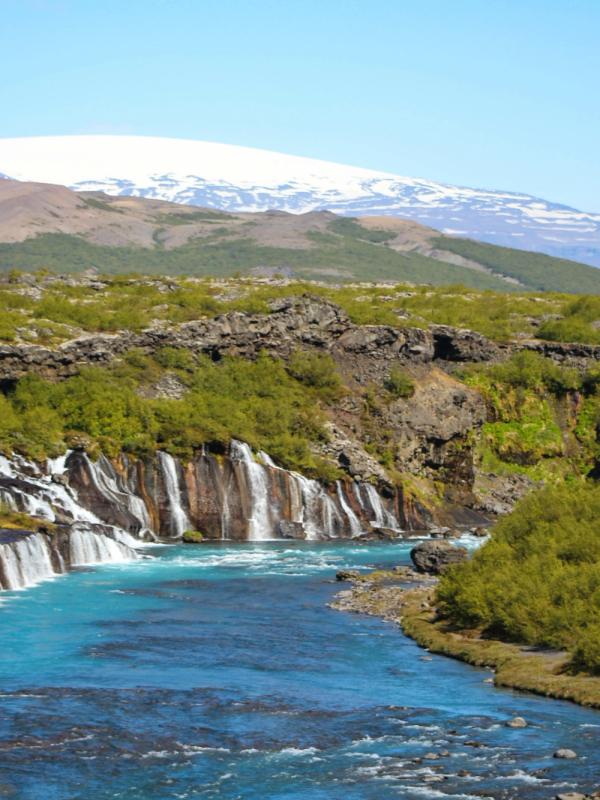
Exploring Iceland’s Silver Circle: A Journey Through Nature and History
One of the reasons travelers choose Iceland as a destination is its natural beauty. The country has hundreds of astonishing and unique features, and they are so varied that sometimes it is almost impossible to classify them. Luckily, many of them are quite close to each other, so they can be grouped up and visited as part of an easy route. Some of these itineraries have reached international fame, like the Golden Circle, but others remain relatively unknown.
That’s the case of the Silver Circle, in West Iceland, not as famous as its cousin in the southwest. This route offers a perfect blend of natural wonders and cultural treasures, from hot springs and waterfalls to lava caves and historic villages.
Key Takeaways
- The Silver Circle is a scenic route in West Iceland.
- It’s a blend of natural monuments, cultural sites and historic villages.
- It can be done in a day, but it’s best to enjoy it in two or three days.
What to Expect from the Silver Circle
That’s a question that has an ambiguous answer, as it has a bit of everything. It’s a scenic route that connects some of the best things to see and do in West Iceland. This loop is mainly located near the Borgarfjörður fjord and the city of Borgarnes, one of the main cities in this region.
In the Silver Circle, you can expect some of the things this country is known for worldwide. Expect dramatic landscapes shaped by volcanic activity and glacial forces, like the geothermal pools of Deildartunguhver or the large Langjökull Glacier. There are several beautiful waterfalls, like Hraunfossar and Barnafoss, each one different but equally charming. Well, technically, the earlier is a series of waterfalls, but we’ll get into detail later.
Some of the sites in this route are not simply beautiful or impressive. Many of them are also steeped in local folklore. In this route, you’ll be able to connect and learn about Icelandic culture and discover the magic of some of its legends. And there are also a few thrilling activities that can be enjoyed in the Silver Circle. You’ll be able to immerse yourself in the Icelandic culture of geothermal bathing in the Krauma Spa. Or take a ride on the most beloved animal in the country, the Icelandic horse.
The Silver Circle is similar to the two other major scenic routes in Iceland: the famous Golden Circle, in the southwest of the country, and the Diamond Circle, which takes us to the north. However, this one is not as well-known and, for this reason, not as crowded. It’s ideal for those seeking adventure, relaxation, and a quieter, more intimate Icelandic experience.
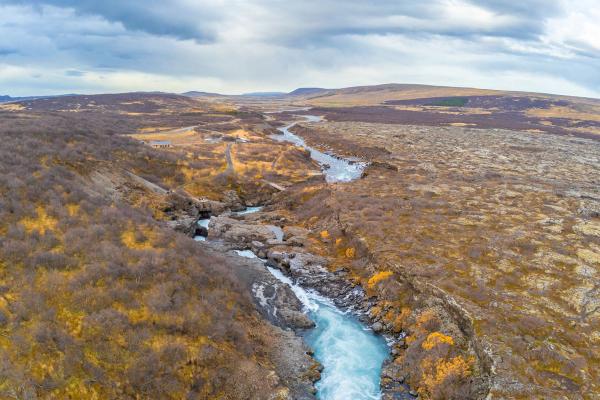
How Long Is the Silver Circle & How to Best Explore It?
The Silver Circle has a total length of approximately 146 kilometers (91 miles) in West Iceland, with a total driving distance from Reykjavík of about 280 kilometers (174 miles) if we count the round trip. If you’re planning on doing it from Reykjavík, the journey begins by heading north on Route 1, also known as the Ring Road, for about 75 kilometers (47 miles) until you reach Borgarnes. This is one of the most important cities in West Iceland and is considered to be the gateway to the Silver Circle. It’s also a great place to grab supplies, like food and water, and fill up your tank.
This drive takes roughly 1 hour from Reykjavik without stops, but you’ll pass beautiful coastal and fjord views, so take your time unless you’re in a hurry (for example, if you’re doing the Silver Circle on a single day). Continue on Route 1 for a little longer and then turn right onto Route 50. The Silver Circle consists mostly of Route 50 and Route 518. One of the stops, the Langjökull glacier, is on Route 550, which connects with Route 518. Then, for the way back, take Route 50 south of the Borgarfjörður fjord until you get on the Ring Road again. As this is a loop, you can make it the other way around, turning right onto Route 50 before the Hvalfjörður Tunnel.
The best way to explore the Silver Circle is by renting a car for flexibility, allowing you to stop at each site at your own pace. A 4WD vehicle is a must in winter due to potential icy roads, but the route is generally accessible year-round. If you want to explore a bit further on each stop, some roads can be gravel, and then you’ll need a 4x4 car.
Plan for a full day to enjoy the main stops, or spread it over two or three days with an overnight stay in Húsafell or Reykholt to fully enjoy the route and all the stops. Borgarnes could also be used as a great base. It’s a charming town with restaurants, a geothermal pool, and the Settlement Center, a museum that deeply explores Iceland's Viking history and the country's earliest settlers. And it’s by the Ring Road, just one hour away from Reykjavik.
What to See in the Silver Circle
The Silver Circle is a string of natural and cultural treasures, each stop offering something special. Here you have the must-see spots on this route.
Deildartunguhver Hot Spring
Geothermal activity is one of the main sources of energy in Iceland. It can be found under the surface in many places on the island, but in not many is as evident as it is in Deildartunguhver, Europe’s most powerful hot spring. It produces a huge amount of hot water, almost to the boiling point, around 97°C (206°F), and is used to power nearby towns like Borgarnes and Akranes. There are wooden walkways that you can walk on safely around the bubbling pools, among rocks of vibrant red partially covered in green moss. As you could imagine, bathing is not allowed here due to the temperature of the water, but this hot spring provides for the nearby Krauma Spa, a great place to enjoy a geothermal bath that we’ll explain later.
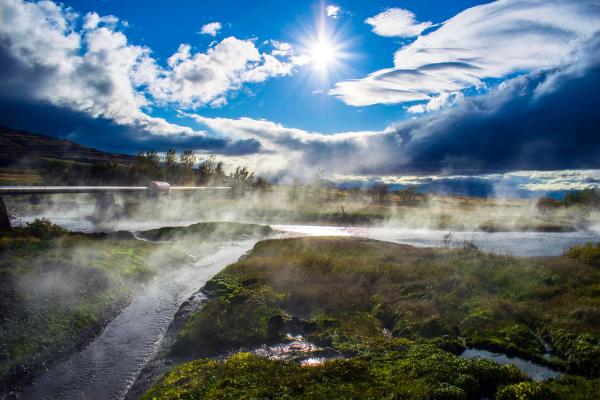
Hraunfossar Waterfalls
A good scenic route in Iceland has to have waterfalls, and, as it couldn’t be any other way, there are three places in the Silver Circle with them. The first is Hraunfossar, which means “lava waterfalls”, and is a series of waterfalls that span for more than 900 meters. The water emerges from the Hallmundarhraun lava field and falls over volcanic rocks into the turquoise Hvítá River below, which is fed by the Langjökull Glacier. There are viewing platforms and it’s a fantastic place to take photos.

Barnafoss Waterfall
Just a short walk from Hraunfossar, Barnafoss, or “Children’s Waterfall,” is a beautiful place with a dark legend attached to it. According to the legend, two children fell into the river while crossing a natural stone bridge and drowned. There’s a short and easy trail that connects Hraunfossar and Barnafoss.
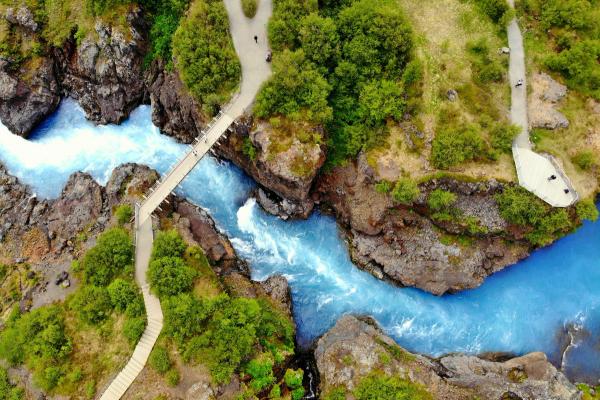
Húsafell
Húsafell is a small settlement located in the heart of the Silver Circle. It’s a historic farm in the middle of a beautiful birch forest, with a lava field nearby and several hiking trails to explore this quiet but fantastic area. It’s a great base for exploring the Silver Circle, as it has a hotel and one of the best camping grounds in Iceland. There’s plenty of activities for all ages at Húsafell.
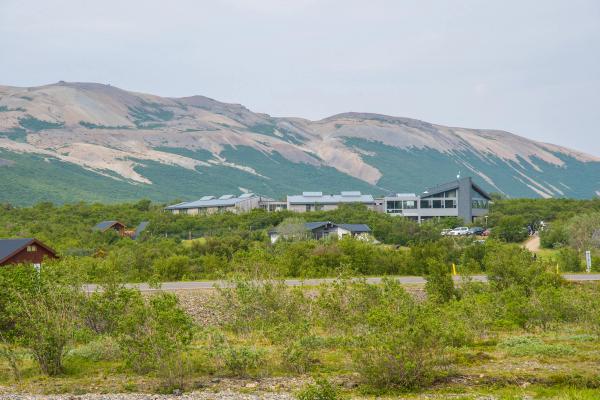
Glanni Waterfall
We get now to another waterfall in the Silver Circle. Not far from Borgarnes, Glanni is a charming waterfall on the Norðurá River. It’s a multi-tiered cascade surrounded by lava fields and vegetation, and it is connected to local legends. It is said that there are elves and huldufólk (hidden people) who live here. There’s a parking area by the waterfall and a short path from it that gets to a viewing platform with panoramic views.
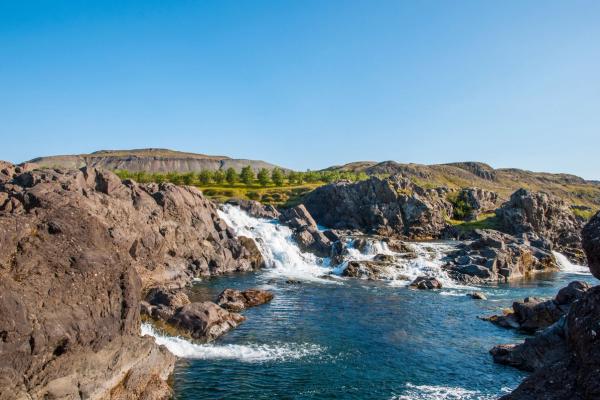
Víðgelmir Lava Cave
Formed around 3,000 years ago, Víðgelmir is Iceland’s longest lava cave. It has a length of 1,585 meters (roughly 1 mile) through the Hallmundarhraun lava field. The cave is full of colorful rock formations, such as stalagmites and stalactites, made by mineral deposits. There are guided tours available that usually last between 2 and 4 hours. The expert guides offer safety gear and insightful information. Booking in advance is essential, as access is restricted to protect this natural marvel.

Langjökull Glacier
This ice giant, whose name means “long glacier,” is the furthest east stop in the Silver Circle, on Route 550. It’s Iceland’s second largest glacier, after the mighty Vatnajökull. There are a lot of ways to enjoy the Langjökull glacier, such as snowmobiling, glacier hiking, and exploring a man-made ice tunnel, the world’s largest of its kind. One of the best things about this ice tunnel is that it’s open all year, something that doesn’t apply to the rest of ice caves in the country, which are only accessible in winter.
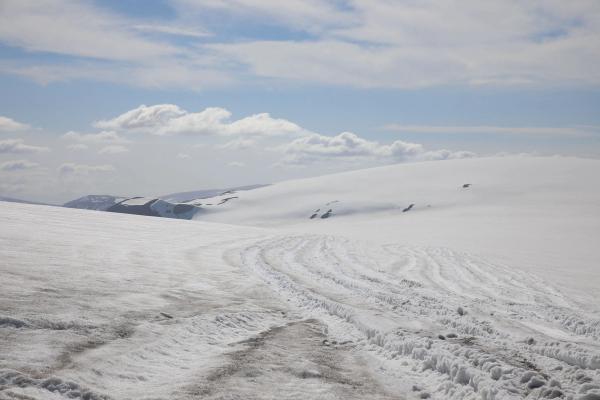
Krauma Spa
One of the things that most travelers want to do when visiting Iceland is discovering the Icelandic bathing culture. And, luckily, that’s something you can also do in the Silver Circle. Krauma Spa is a modern spa with hot and cold tubs, steam baths, a relaxing pool, and a restaurant serving local Icelandic food. It’s recommended to book in advance, especially in summer, which is peak season.

Reykholt
Reykholt is a historic village mainly known for being the hometown of Snorri Sturluson, a 13th-century poet and historian. In the town we can find Snorralaug, one of Iceland’s oldest geothermal pools, and Snorrastofa, a research center with exhibits on medieval history. It’s a great place to learn about the country’s history and Viking past, making it a must for history enthusiasts.

Sturlureykir Horse Farm
The Icelandic horse is, probably, the country’s most beloved animal. These small but sturdy creatures are known for their friendly behavior and unique gait. Sturlureykir Horse Farm is a great place to get in touch with these horses. They offer guided tours on horseback to explore the surrounding geothermal area. Guests can also sample traditional rye bread baked in the ground using geothermal heat.

The Weather in the Silver Circle
Iceland’s weather is famously unpredictable, swinging from sun to rain at a moment’s notice. West Iceland, where the Silver Circle lies, is not as cold as the central Highlands or the north of the country. On the other hand, it’s usually wetter and windier, thanks to the winds coming from the Atlantic Ocean. Rain is common and the wind chill is a factor to consider, so it’s important to be prepared. Here’s what to expect season by season.
Spring (April and May)
Spring wakes up slowly, with temperatures hovering between 0°C and 7°C (32°F to 45°F). Rain showers are frequent, and snow lingers into early April, especially on higher elevations. By May, you’ll get 12-15 hours of daylight, perfect for long days out. The trails are usually wet and muddy, and the temperatures can drop drastically from one day to another.
Summer (June to August)
This season has, objectively, the best conditions, with temperatures ranging from 8°C to 15°C (46°F to 59°F), with highs that can reach up to 20°C (68°F) in certain parts of the Silver Circle. The days are really long, with almost 24 hours of natural light by the last weeks of June, which means you can explore late. However, it’s common to have occasional showers. These mixed conditions make it necessary to be prepared for a bit of everything.
Autumn (September and October)
The conditions are not very different to spring, but moving in the opposite direction. The temperature drops to 5°C to 10°C (41°F to 50°F), with stronger winds and heavier rain. The areas with vegetation get a beautiful palette of colors, with shades of red, orange and golden, creating beautiful contrasts. There could be the first days of snow by mid-October.
Winter (November to March)
Winters are long and harsh in Iceland, with temperatures usually moving between -5°C to 2°C (23°F to 36°F). Almost everything is covered in snow and ice, which makes driving tricky. The days are very short, with barely 4 to 6 hours of natural light. Some routes can be closed if the weather is adverse, so it’s essential to check the conditions regularly. On the other hand, this is the time with the most chances to see the Northern Lights.
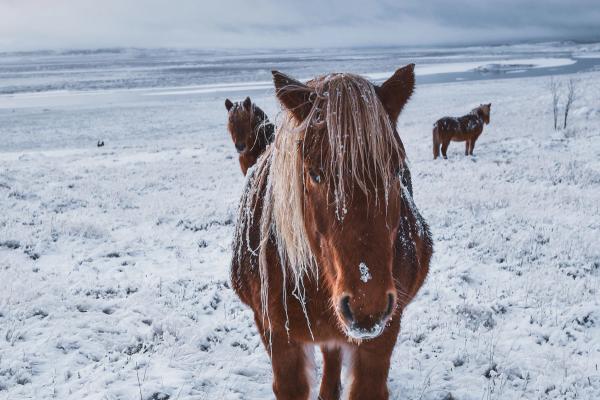
What to Pack for the Silver Circle
The Silver Circle is an accessible route with good conditions most of the year. However, there are a few items that should be in every traveler’s suitcase.
- Waterproof Jacket and Pants: Essential for rain and wind. Also convenient near waterfalls and hot springs.
- Layered Clothing: As the weather changes so much within the same season, or even the same day, the best way to adapt is to wear layers. Thermal base layers, fleece or wool intermediate layer, and a waterproof outer layer.
- Sturdy Hiking Boots: Waterproof boots with a good grip for trails and slippery surfaces.
- Hat, Gloves, and Scarf: To stay warm in chilly winds, particularly in winter, autumn, and spring.
- Reusable Water Bottle and Snacks: Some stops have no facilities or can be a bit far from the nearest shop, so it’s a good idea to have water and food for the day.
- Sunscreen and Sunglasses: For summer’s bright days and reflection on snow in winter.
- Swimsuit and Towel: You normally can rent these items at spas, but it’s much more convenient if you bring your own.
- Daypack: To carry essentials during short hikes and tours.
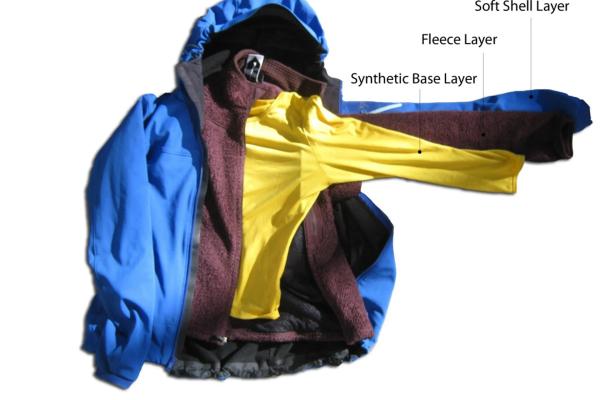
Travel Tips
- Book in Advance: Some activities, like visits to Víðgelmir Lava Cave, Langjökull ice tunnel, and Krauma Spa, can fill up quickly, especially during peak season. This also applies to accommodation in the region.
- Check Road Conditions: As we have mentioned, the weather can have a huge impact on the roads, especially in winter, as some roads may close due to snow or ice.
- Start Early: Whether you’re coming from Reykjavik or staying in the area, starting the day early will help you maximize daylight and avoid crowds at the most popular spots, like Hraunfossar.
- Bring Cash and Card: Most places accept cards, but some businesses may not take them.
- Respect Nature: Stay on marked paths to protect the fragile ecosystems, don’t disturb the wildlife, and take all your trash with you.
- Download Offline Maps: Cell phone service can be spotty or nonexistent in certain areas. Download offline maps on your phone or use an old-school paper map.
- Monitor the Weather: As the weather can change so quickly, it can make you consider changing some plans, or swap the order in which you’re going to see them. The best source of information is the Icelandic Met Office.
Conclusion
Iceland has so much to see in a small territory, that there are routes that connect several attractions in an easy way. The Silver Circle is a fantastic route with some of the best in West Iceland. It’s well-connected, easy to navigate, and has a bit of everything. From geothermal pools to ancient lava tubes, each stop reveals a different layer of this amazing Nordic country. Pack your things, rent a car, and get ready to discover this lesser-known gem.
